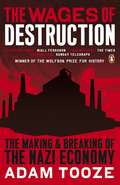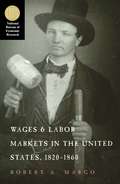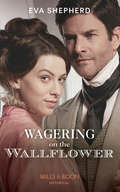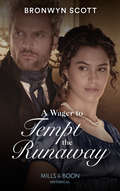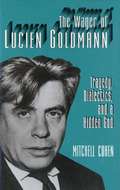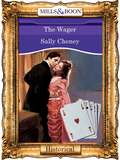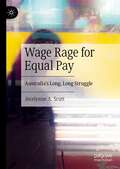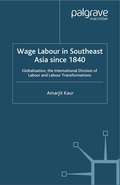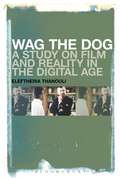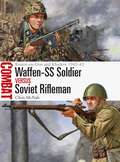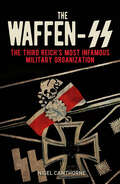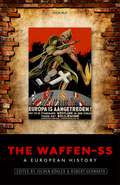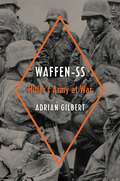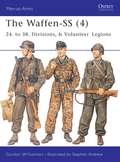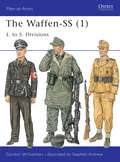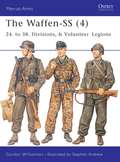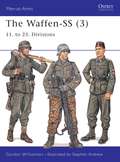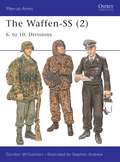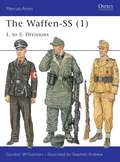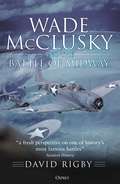- Table View
- List View
The Wages of Destruction: The Making And Breaking Of The Nazi Economy
by Adam ToozeThis chilling, fascinating new book is the first fully to get to grips with how Hitler's Nazi empire REALLY functioned. There was no aspect of Nazi power untouched by economics - it was Hitler's obsession and the reason the Nazis came to power in the first place. The Second World War was fought, in Hitler's view, to create a European Empire strong enough to take on the United States - a last chance for Europe to dig itself in before being swept away by the USA's ever greater power. But, as THE WAGES OF DESTRUCTION makes clear, Hitler was never remotely strong enough to beat either Britain or the Soviet Union - and never even had a serious plan as to how he might defeat the USA. It took years of fighting and the deaths of millions of people to destroy the Third Reich, but effectively World War II in Europe was fought in pursuit of a fantasy: the years in which Western Europe could settle the world's fate were, by 1939, long past. This is a major book by a major author and will provoke an enormous amount of controversy and debate.
Wages and Labor Markets in the United States, 1820-1860 (National Bureau of Economic Research Series on Long-Term Factors in Economic Development)
by Robert A. MargoResearch by economists and economic historians has greatly expanded our knowledge of labor markets and real wages in the United States since the Civil War, but the period from 1820 to 1860 has been far less studied. Robert Margo fills this gap by collecting and analyzing the payroll records of civilians hired by the United States Army and the 1850 and 1860 manuscript federal Censuses of Social Statistics. New wage series are constructed for three occupational groups—common laborers, artisans, and white-collar workers—in each of the four major census regions—Northeast, Midwest, South Atlantic, and South Central—over the period 1820 to 1860, and also for California between 1847 and 1860. Margo uses these data, along with previously collected evidence on prices, to explore a variety of issues central to antebellum economic development. This volume makes a significant contribution to economic history by presenting a vast amount of previously unexamined data to advance the understanding of the history of wages and labor markets in the antebellum economy.
Wagering On The Wallflower (Young Victorian Ladies #1)
by Eva ShepherdA wallflower And an elegant gentleman…
A Wager To Tempt The Runaway (The Rebellious Sisterhood #3)
by Bronwyn ScottShe’s a free spirit He’s a serious businessman
The Wager of Lucien Goldmann: Tragedy, Dialectics, and a Hidden God
by Mitchell CohenIn The Wager of Lucien Goldmann, Mitchell Cohen provides the first full-length study of this major figure of postwar French intellectual life and champion of socialist humanism. While many Parisian leftists staunchly upheld Marxism's "scientificity" in the 1950s and 1960s, Lucien Goldmann insisted that Marxism was by then in severe crisis and had to reinvent itself radically if it were to survive. He rejected the traditional Marxist view of the proletariat and contested the structuralist and antihumanist theorizing that infected French left-wing circles in the tumultuous 1960s.Highly regarded by thinkers as diverse as Jean Piaget and Alasdair MacIntyre, Goldmann is shown here as a socialist who, unlike many others of his time, refused to portray his aspirations for humanity’s future as an inexorable unfolding of history’s laws. He saw these aspirations instead as a wager akin to Pascal’s in the existence of God. “Risk,” Goldmann wrote in his classic study of Pascal and Racine, The Hidden God, “possibility of failure, hope of success, and the synthesis of the three in a faith which is a wager are the essential constituent elements of the human condition.” In The Wager of Lucien Goldmann, Cohen retrieves Goldmann’s achievement—his “genetic structuralist” method, his sociology of literature, his libertarian socialist politics.Originally published in 1994.The Princeton Legacy Library uses the latest print-on-demand technology to again make available previously out-of-print books from the distinguished backlist of Princeton University Press. These editions preserve the original texts of these important books while presenting them in durable paperback and hardcover editions. The goal of the Princeton Legacy Library is to vastly increase access to the rich scholarly heritage found in the thousands of books published by Princeton University Press since its founding in 1905.
A Wager for the Widow: Warrior Of Ice Running Wolf A Wager For The Widow (Mills And Boon Historical Ser.)
by Elisabeth Hobbes‘I SUPPOSE A KISS OF GRATITUDE IS OUT OF THE QUESTION?’ Widowed Lady Eleanor Peyton has chosen a life of independence. Living alone on her rocky coastal outcrop, she’s cut herself off from the world of men – until William Rudhale saves her life and demands a kiss!
The Wager
by Sally CheneyNot To Be Trusted A rogue draped in a mantle of savagery and civilization was the only way to describe Peter Desmond, she'd decided. But Marianne Trenton shuddered to realize she was dangerously intrigued, indeed, beguiled , by the very man she'd sworn to destroy!
Wage Rage for Equal Pay: Australia’s Long, Long Struggle
by Jocelynne A. ScuttThis book makes a major contribution to the continuing legal and historical struggle for equal pay in Australia, with international references, including Canada, the UK and US. It takes law, history and women’s and gender studies to analyse and recount campaigns, cases and debates. Industrial bodies federally and around Australia have grappled with this issue from the early-twentieth century onwards. This book traces the struggle through the decades, looking at women's organisations activism and demands, union ‘pro’ and ‘against’ activity, and the 'official' approach in tribunals, boards and courts.
Wage Labour in Southeast Asia Since 1840: Globalization, the International Division of Labour and Labour Transformations (A Modern Economic History of Southeast Asia)
by A. KaurAmarjit Kaur examines wage labour's role in economic growth and change in Southeast Asia since 1840. Her study focuses on globalization; the international division of labour and how transnational economic processes shaped and continue to shape labour systems. There are five main themes - labour processes, migration and labour systems; labour circulation or mobility; the gendered nature of labour relations; and, class consciousness, worker organization and labour standards. A wide-ranging study which will be of great interest to historians, economists and Asia specialists.
Wag the Dog: A Study On Film And Reality In The Digital Age
by Eleftheria ThanouliWag the Dog is a film that became a media event and a cultural icon because it inadvertently short-circuited the distance that is supposed to separate reality and fiction. The film's narration challenges the established boundaries between the fiction and nonfiction tradition, as Barry Levinson, the director, embeds his interest in documentary filmmaking and complicates the issue of narrative agency in the way he frames the story. The examination of the historical and social context in which it was produced, exhibited and received worldwide enables the author to illuminate a series of changes in the way a fiction film reflects and interacts with reality, urging us to reconsider some of our central and long-standing concepts or even paradigms in film theory. Eleftheria Thanouli provides new insights into a series of issues from both classical and contemporary film theory, like the conceptual and ontological stakes in the use of digital technology, the impact of mass media on public memory and the political role of cinema in a globalized and conglomerated world.
Waffen-SS Soldier vs Soviet Rifleman: Rostov-on-Don and Kharkov 1942–43 (Combat)
by Chris McNabFully illustrated, this study assesses the Soviet and Waffen-SS troops who contested the cities of Kharkov and Rostov-on-Don on the Eastern Front during 1942–43. As the Axis invasion of the Soviet Union unfolded, two places that suffered exceptionally severely were Kharkov (now Kharkiv) in Ukraine and Rostov-on-Don in Russia. In total, Kharkov would change hands violently four times between October 1941 and August 1943, and Rostov-on-Don also four times between November 1941 and February 1943. In this book, Chris McNab examines the fighting men of the Red Army and the Waffen-SS who clashed in three battles – one for Rostov (July 1942) and two for Kharkov (February–March and August). He clearly explains the key differences between these two opponents – training, tactics, weaponry, ideology and motivation – and examines how these differences played out in the three engagements, which ranged from open-terrain combined-arms battles to close-quarters street fighting in major urban zones. The text is complemented by specially commissioned artwork and mapping and carefully chosen archive photographs.
Waffen-SS Soldier vs Soviet Rifleman: Rostov-on-Don and Kharkov 1942–43 (Combat)
by Chris McNabFully illustrated, this study assesses the Soviet and Waffen-SS troops who contested the cities of Kharkov and Rostov-on-Don on the Eastern Front during 1942–43. As the Axis invasion of the Soviet Union unfolded, two places that suffered exceptionally severely were Kharkov (now Kharkiv) in Ukraine and Rostov-on-Don in Russia. In total, Kharkov would change hands violently four times between October 1941 and August 1943, and Rostov-on-Don also four times between November 1941 and February 1943. In this book, Chris McNab examines the fighting men of the Red Army and the Waffen-SS who clashed in three battles – one for Rostov (July 1942) and two for Kharkov (February–March and August). He clearly explains the key differences between these two opponents – training, tactics, weaponry, ideology and motivation – and examines how these differences played out in the three engagements, which ranged from open-terrain combined-arms battles to close-quarters street fighting in major urban zones. The text is complemented by specially commissioned artwork and mapping and carefully chosen archive photographs.
The Waffen-SS: The Third Reich's Most Infamous Military Organization
by Nigel CawthorneThe best political weapon is the weapon of terror. Cruelty commands respect. Men may hate us. But we don't ask for their love - only for their fear - Heinrich Himmler, leader of the Waffen-SS.The Waffen-SS were the armed division of the feared Schutzstaffel, and the private army of Adolf Hitler. They developed a reputation as brutal soldiers, willing to carry out any order, no matter how terrible. Fanatically devoted to Nazism and unswervingly loyal to the Führer, they were committed some of the most horrific atrocities of World War II as they sought to enforce the racial policies of the Nazi state.In this unflinching and engrossing account, Nigel Cawthorne provides a detailed look at one of the most chilling organizations ever conceived by the human imagination. He examines their elite position under the Nazi regime, the superior weapons they were afforded, their involvement in the murderous crimes of the Holocaust, and the way they thrust their claws into every aspect of German life.Illustrated with reportage photographs, this is the story of the rise and fall of one of the most evil organizations the world has ever seen.
The Waffen-SS: A European History
by Robert Gerwarth Jochen BöhlerThis is the first systematic pan-European study of the hundreds of thousands of non-Germans who fought — either voluntarily or under different kinds of pressures — for the Waffen-SS (or auxiliary police formations operating in the occupied East). Building on the findings of regional studies by other scholars — many of them included in this volume — The Waffen-SS aims to arrive at a fuller picture of those non-German citizens (from Eastern as well as Western Europe) who served under the SS flag. Where did the non-Germans in the SS come from (socially, geographically, and culturally)? What motivated them? What do we know about the practicalities of international collaboration in war and genocide, in terms of everyday life, language, and ideological training? Did a common transnational identity emerge as a result of shared ideological convictions or experiences of extreme violence? In order to address these questions (and others), The Waffen-SS adopts an approach that does justice to the complexity of the subject, adding a more nuanced, empirically sound understanding of collaboration in Europe during World War II, while also seeking to push the methodological boundaries of the historiographical genre of perpetrator studies by adopting a transnational approach.
Waffen-SS: Hitler's Army at War
by Adrian GilbertFrom an award-winning and bestselling historian, the first comprehensive military history in over fifty years of Hitler's famous and infamous personal army: the Waffen-SS.The Waffen-SS was one of the most feared combat organizations of the twentieth century. Originally formed as a protection squad for Adolf Hitler it became the military wing of Heinrich Himmler's SS and a key part of the Nazi state, with nearly 900,000 men passing through its ranks. The Waffen-SS played a crucial role in furthering the aims of the Third Reich which made its soldiers Hitler's political operatives. During its short history, the elite military divisions of the Waffen-SS acquired a reputation for excellence, but their famous battlefield record of success was matched by their repeated and infamous atrocities against both soldiers and civilians.Waffen-SS is the first definitive single-volume military history of the Waffen-SS in more than fifty years. In considering the actions of its leading personalities, including Himmler, Sepp Dietrich, and Otto Skorzeny, and analyzing its specialist training and ideological outlook, eminent historian Adrian Gilbert chronicles the battles and campaigns that brought the Waffen-SS both fame and infamy.
The Waffen-SS: 24. To 38. Divisions, And Volunteer Legions (Men-at-arms Ser. #420)
by Gordon WilliamsonIn 1944–45 the Waffen-SS formed many nominal 'divisions' from a motley range of sources, whose battlefield value was as varied as their backgrounds. The best were built around existing Western European volunteer regiments; some, raised from Central Europeans and Russians, were strong in numbers but weak in morale; some were of negligible size, scraped together from remnants and trainees; and some were sinister 'anti-partisan' gangs, assembled from the military dregs of the Eastern Front. Illustrated with rare photographs from private collections and meticulous colour artwork, this final title in our sequence details their organisation, uniforms and insignia, and summarises their battle records.
The Waffen-SS: 1. to 5. Divisions (Men-at-Arms)
by Gordon Williamson Stephen AndrewDespite being disdained by the German Army's professional officer corps, the military branch of the Nazi SS security organisation grew from an initial strength of only a handful of battalions at the outbreak of war in 1939 to hundreds of thousands of troops in dozens of divisions. The battlefield reputation of the premier armoured and mechanised divisions would become second to none; lavishly equipped and regarded as utterly reliable, they were thrown into many desperate battles on both Western and Eastern fronts, often achieving remarkable results. Illustrated with rare photographs, this first of four Men-at-Arms titles details the organisation, uniforms and insignia of the Waffen-SS.
The Waffen-SS: 24. to 38. Divisions, & Volunteer Legions (Men-at-Arms)
by Gordon Williamson Stephen AndrewIn 1944–45 the Waffen-SS formed many nominal 'divisions' from a motley range of sources, whose battlefield value was as varied as their backgrounds. The best were built around existing Western European volunteer regiments; some, raised from Central Europeans and Russians, were strong in numbers but weak in morale; some were of negligible size, scraped together from remnants and trainees; and some were sinister 'anti-partisan' gangs, assembled from the military dregs of the Eastern Front. Illustrated with rare photographs from private collections and meticulous colour artwork, this final title in our sequence details their organisation, uniforms and insignia, and summarises their battle records.
The Waffen-SS: 11. to 23. Divisions (Men-at-Arms)
by Gordon Williamson Stephen AndrewThe Waffen-SS grew from a handful of obscure infantry battalions in 1939, to a force of more than 30 divisions by the end of World War II, including units of every type and every level of battlefield value. The mid-war divisions covered in this third title represent that range, from some of the most effective German and Western European volunteer formations – e.g. the 12. SS-Pz Div 'Hitlerjugend', and the Scandinavians and Dutchmen of the 11. 'Nordland' and 23. 'Nederland' divisions – to the Bosnian Muslims of the anti-partisan 13. 'Handschar' Division. Illustrated with rare photographs from private collections and meticulous colour artwork, the text details their organization, uniforms and insignia, and summarizes their battle records.
The Waffen-SS: 6. to 10. Divisions (Men-at-Arms)
by Gordon Williamson Stephen AndrewThe military branch of the Nazi SS security organisation grew by the end of World War II from a handful of poorly regarded infantry battalions in 1939, into a force of more than 30 divisions including units of every type. Their battlefield reputation varied widely, from the premier armoured divisions which formed Germany's utterly reliable spearheads on both main fronts, to low quality 'anti-partisan' units. The divisions covered in this second of four titles include the first mountain and cavalry units, and two of the remarkable new Panzer divisions raised in the great 1943 expansion. Illustrated with rare photographs from private collections, the text details their organisation, uniforms and insignia, and summarises their battle record.
The Waffen-SS: 1. to 5. Divisions (Men-at-Arms #Vol. 401)
by Gordon Williamson Stephen AndrewDespite being disdained by the German Army's professional officer corps, the military branch of the Nazi SS security organisation grew from an initial strength of only a handful of battalions at the outbreak of war in 1939 to hundreds of thousands of troops in dozens of divisions. The battlefield reputation of the premier armoured and mechanised divisions would become second to none; lavishly equipped and regarded as utterly reliable, they were thrown into many desperate battles on both Western and Eastern fronts, often achieving remarkable results. Illustrated with rare photographs, this first of four Men-at-Arms titles details the organisation, uniforms and insignia of the Waffen-SS.
The Waffen-SS: 6. to 10. Divisions (Men-at-Arms #404)
by Gordon Williamson Stephen AndrewThe military branch of the Nazi SS security organisation grew by the end of World War II from a handful of poorly regarded infantry battalions in 1939, into a force of more than 30 divisions including units of every type. Their battlefield reputation varied widely, from the premier armoured divisions which formed Germany's utterly reliable spearheads on both main fronts, to low quality 'anti-partisan' units. The divisions covered in this second of four titles include the first mountain and cavalry units, and two of the remarkable new Panzer divisions raised in the great 1943 expansion. Illustrated with rare photographs from private collections, the text details their organisation, uniforms and insignia, and summarises their battle record.
The Waffen-SS: 11. to 23. Divisions (Men-at-Arms #415)
by Gordon Williamson Stephen AndrewThe Waffen-SS grew from a handful of obscure infantry battalions in 1939, to a force of more than 30 divisions by the end of World War II, including units of every type and every level of battlefield value. The mid-war divisions covered in this third title represent that range, from some of the most effective German and Western European volunteer formations – e.g. the 12. SS-Pz Div 'Hitlerjugend', and the Scandinavians and Dutchmen of the 11. 'Nordland' and 23. 'Nederland' divisions – to the Bosnian Muslims of the anti-partisan 13. 'Handschar' Division. Illustrated with rare photographs from private collections and meticulous colour artwork, the text details their organization, uniforms and insignia, and summarizes their battle records.
The Waffen-SS: A European History
This is the first systematic pan-European study of the hundreds of thousands of non-Germans who fought — either voluntarily or under different kinds of pressures — for the Waffen-SS (or auxiliary police formations operating in the occupied East). Building on the findings of regional studies by other scholars — many of them included in this volume — The Waffen-SS aims to arrive at a fuller picture of those non-German citizens (from Eastern as well as Western Europe) who served under the SS flag. Where did the non-Germans in the SS come from (socially, geographically, and culturally)? What motivated them? What do we know about the practicalities of international collaboration in war and genocide, in terms of everyday life, language, and ideological training? Did a common transnational identity emerge as a result of shared ideological convictions or experiences of extreme violence? In order to address these questions (and others), The Waffen-SS adopts an approach that does justice to the complexity of the subject, adding a more nuanced, empirically sound understanding of collaboration in Europe during World War II, while also seeking to push the methodological boundaries of the historiographical genre of perpetrator studies by adopting a transnational approach.
Wade McClusky and the Battle of Midway
by David RigbyDuring the Battle of Midway in June 1942, US Navy dive bomber pilot Wade McClusky proved himself to be one of the greatest pilots and combat leaders in American history, but his story has never been told – until now. It was Wade McClusky who remained calm when the Japanese fleet was not where it was expected to be. It was he who made the counterintuitive choice to then search to the north instead of to the south. It was also McClusky who took the calculated risk of continuing to search even though his bombers were low on fuel and may not have enough to make it back to the Enterprise. His ability to remain calm under enormous pressure played a huge role in the US Navy winning this decisive victory that turned the tide of war in the Pacific. This book is the story of exactly the right man being in exactly the right place at exactly the right time. Wade McClusky was that man and this is his story.
